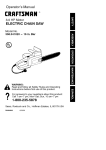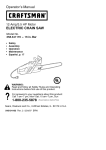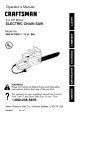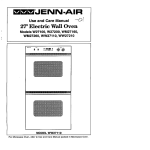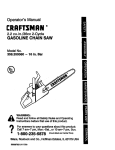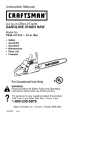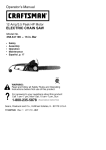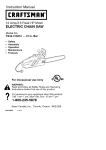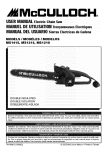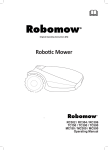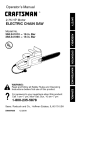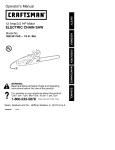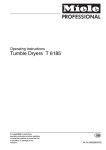Download Craftsman 358.341060 Operator`s manual
Transcript
Operator's Manual CRAFTSMAN 12 Amp/3.5 HP Motor ELECTRIC CHAIN SAW Model No. 358.341060 - 16 in. Bar ® & WARNING: Read and follow all Safety Rules and Operating Instructions before first use of this product. For answers Call 7 am-7 to your questions about this product: pm, Mon-Sat; 10 am-7 pm, Sun 1-800-235-5878 Sears, 530087623 Roebuck 07/13/99 (Hours and Co., Hoffman listed are Central Time) Estates, IL 60179 U.S.A. Warranty Safety Rules Assembly Operation Maintenance Service and Adjustments 2 2 6 7 12 13 FULL ONE YEAR WARRANTY Storage Troubleshooting Common Chain Saw Terms Spanish Parts Ordering ON CRAFTSMAN ELECTRIC CHAIN 14 15 15 17 Back SAW. If this Craftsman Electric Chain Saw fails to perform properly due to a defect in material or workmanship within (1) year from the date of purchase, Sears will repair or replace it, free of charge. This warranty excludes the bar and chain, which are expendable come worn during normal use. parts and be- If this Craftsman Electric Chain Saw is used for commercial purposes, this warranty applies for only 90 days from the date of purchase. If this Craftsman Electric Chain Saw is used for rental purposes, this warranty applies for only 30 days from the date of purchase. This warranty applies only while this product is in use in the United States. WARRANTY SERVICE IS AVAILABLE BY RETURNING THE CRAFTSMAN ELECTRIC CHAIN SAW TO THE NEAREST SEARS SERVICE CENTER IN THE UNITED STATES. This warranty gives you specific which vary from state to state. Sears, Roebuck legal rights, and you may also have other rights and Co., Inc., Hoffman WARNING: When using an electric chain saw, basic safety precautions, including the following, should always be followed to reduce the risk of fire, electric shock, and injury to persons. Read all instructions. WARNING: Always disconnect power source when making repairs. Because a chain saw is a high-speed woodcutting tool, careless or improper use of this tool can cause serious injury. PLAN AHEAD • Restrict the use of your saw to adult users who understand and can follow the safety rules, precautions, and operating instructions found in this manual. • Keep children away. Do not let visitors contact chain saw or extension cord. All visitors should be kept at least 30 feet (10 meters) away from work area. Estates, Hearing Protection ''_ IL 60179 _ ig, g.-_---- Snug Fitting _ Clothing U.S.A. Safety Hat Eye Protection Heavy Duty Gloves Safety Shoes _ Safety Chaps I.III Dress properly. Wear protective gear. Always use steel-toed safety footwear with non-slip soles; snug-fitting clothing; heavy-duty, non-slip gloves; eye protection such as non-fogging, vented goggles or face screen; an approved safety hard hat; and sound barriers (ear plugs or mufflers) to protect your hearing. Regular users should have hearing checked regularly as chain saw noise can damage hearing. • Secure hairabove shoulder length. Do MAINTAIN YOUR SAW IN GOOD notwear loose clothing orjewelry; they WORKING ORDER cangetcaught inmoving parts. • Have all chain saw service per• Keep allpartsofyourbody away formed by a Sears Service Center fromthechainwhen sawisrunning. except the items listed in the mainte• Donothandle oroperate achain saw nance section of this manual. when youarefatigued, ill,upset, orif • Make certain saw chain stops movyouhave taken alcohol, drugs, orme- ing when trigger switch is released. dication. Youmust beingoodphysical• Keep the handles dry and clean and condition andmentally alert. Ifyou free from oil and grease. have anycondition thatmight beagKeep oil cap and fasteners securely gravated bystrenuous work, check • tightened. withdoctor before operating. • Nonconforming replacement compoWatch what youaredoing. Usecom- nents or the removal of safety devices monsense. may cause damage to the unit and • Donotstartcutting untilyouhavea possible injury to the operator or byclear workarea, secure footing, and standers. Use only Craftsman accesespecially ifyouarefelling atree,a and replacement parts as recretreat path.Keep work areaclean. sories ommended. Never modify your saw. Cluttered areas invite injuries. • Maintain chain saw with care. OPERATE YOUR SAW SAFELY • Do not operate with one hand. Serious injury to the operator, helpers, or bystanders may result from onehanded operation. A chain saw is intended for two-handed use. • Do not operate saw from a ladder or in a tree. • Make sure the chain will not make contact with any object while starting the saw. Never start the saw when the guide bar is in a cut. • Don't force chain saw. It will do the job better and safer at the rate for which it was intended. • Do not put pressure on the saw, especially at the end of the cut. Doing so can cause you to lose control when the cut is completed. • Stop the saw before setting it down. • Hand carry saw only when motor is stopped. Carry the chain saw by the front handle with the saw stopped, finger off the switch, the guide bar and saw chain to the rear. • Use the right tool, cut wood only. Don't use chain saw for purpose not intended; for example, don't use chain saw for cutting plastic, masonry, non-wood building materials. • Use extreme caution when cutting small size brush and saplings because the tender material may catch the saw chain and be whipped toward you or pull you off balance. • When cutting a limb that is under tension be alert for spring back so you will not be struck when the tension in the wood fibers is released. • Keep unit sharp and clean for better and safer performance. • Follow instructions for lubricating and changing accessories. • Unplug the chain saw from the power source when not in use, before servicing, and when changing accessories and attachments, such as saw chain and guard. • Check for damaged parts. Before further use of the chain saw, a guard or other part that is damaged should be carefully checked to determine that it will operate properly and perform its intended function. Check for alignment of moving parts, binding of moving parts, breakage of parts, mounting and any other conditions that may affect its operation. A guard or other part that is damaged should be properly repaired or replaced by a Sears Service Center unless otherwise indicated elsewhere in the operator's manual. • Do not operate a chain saw that is damaged, improperly adjusted, or is not completely and securely assembled. Inspect chain saw cords periodically, and if damaged have repaired by a Sears Service Center. • When not in use, chain saws should be stored in a dry, high or locked-up place out of the reach of children. • When storing saw, unplug and use a bar sheath or carrying case. Store idle chain saw. ELECTRICAL SAFETY • Use a voltage supply as shown on unit. • Avoid dangerous environments. • Toavoid thepossibility ofelectric Don'tuseappliances indamp orwet shock, avoid bodycontact withany locations. Don't useinrain. grounded conductor, suchasmetal • Avoid dangerous situations. Donot fences orpipes. useinthepresence offlammable liq- • Ground Fault Circuit Interrupter uidsorgases toavoid creating afire (GFCI) protection should beprovided oroutlet tobeused. Reorexplosion and/or causing damage oncircuit tounit. ceptacles areavailable having built• Toreduce theriskofelectrical shock, inGFCI protection andmaybeused thisappliance hasapolarized plug forthismeasure ofsafety. Inspect (oneblade iswider thantheother) and chainsawcords periodically andif willrequire theuseofa polarized exdamaged, haverepaired byaSears Service Center. tension cord. Theappliance plugwillfit intoapolarized extension cordonly GUARD AGAINST KICKBACK oneway. Iftheplugdoes notfitfully Follow a ll s afety rules t ohelp avoid kickintotheextension cord, reverse the andother forces which canresult plug. Iftheplugstilldoes notfit,obtain back inserious injury. acorrect polarized extension cord. A Kickback Path polarized extension cord willrequire theuseofapolarized walloutlet. This plugwillfitintothepolarized walloutlet onlyoneway. Ifplugdoes notfitfully intothewalloutlet, reverse theplug. If theplugstilldoes notfit,contact a qualified electrician toinstall theproper Avoid Obstructions walloutlet. Donotchange theequipment plug, extension cordreceptacle, orextension cordpluginanyway. • Toreduce riskofelectrical shock, use extension cords specifically marked as suitable foroutdoor appliances having electrical rating notlessthan therating Clear The Working Area ofunit.Cord must bemarked withsufWARNING; Rotational Kickback can fix'_#V". Make sureyourextension cord isingoodcondition. Inspect extensionoccur when the moving chain contacts cordbefore useandreplace ifdam- an object at the upper portion of the tip aged. Anundersized extension cord of the guide bar. Contact at the upper willcause adrop inlinevoltage result- portion of the tip of the guide bar can inginlossofpower andoverheating. If cause the chain to dig into the object, which stops the chain for an instant. indoubt, usethenextheavier gauge. The result is a lightning fast, reverse Thelower thegauge number, the reaction which kicks the guide bar up heavier thecord(see "Select anexand back toward the operator. tension cord"). • Donotabuse cord.Never carrythe Pinch-Kickback and Pull-In occur when unitbytheextension cordoryank the chain is suddenly stopped by being pinched, caught, or by contacting a forextension cordtodisconnect unit. • Secure extension cordtopower cord eign object in the wood. This sudden of the chain results in a revertoprevent disconnection fromunit. stopping • Donotusetheunitiftheswitch does sal of the chain force used to cut wood notturntheunitonandoffproperly, and causes the saw to move in the oporifthelockout doesnotwork. Re- posite direction of the chain rotation. pairs totheswitch must bemade by Pinch-Kickback drives the saw straight aSears Service Center. back toward the operator. Pull-In pulls saw away from the operator. • Keep extension cordclear ofopera- the torandobstacles atalltimes. Posi- KICKBACK WARNING: tioncordsothatitwillnotbecaught Kickback can occur when the moving onbranches. Donotexpose cords to chain contacts an object at the upper heat,oil,water, orsharp edges. portion of the tip of the guide bar or when thewood closes inandpinches to pinch the top of or otherwise stop thesawchain inthecut.TheComputed the chain. Kickback Angle (CKA) listed onyour • Do not cut more than one log at a time. sawandlisted inthefollowing CKA Table represents theangle ofkickback • Do not twist the saw as the bar is withdrawn from an undercut when yourbarandchain combinations will have when tested inaccordance with bucking. CSA andANSI standards. Computed Avoid Pull-In: angles represented intheCKA column • Always begin cutting with the saw at indicate totalenergy andangle full speed and the saw housing associated without achain brake. When against wood. purchasing replacements, consider- • Use wedges made of plastic or ations should begiven tothelower CKA wood. Never use metal to hold the values. Inallcases, lower CKAvalues cut open. represent asafer operating environment MAINTAIN CONTROL: fortheuser. The following precautions should be Donotrelyexclusively upon thesafety followed to minimize kickback. devices builtintoyoursaw. good, firm grip on the saw with • Either ofthese reactions maycause • Aboth hands will help you maintain youtolosecontrol ofthesawwhich control. Don't let go. Grip the rear couldresult inserious injury. handle with your right hand whether • Pinching thesawchainalong thetip oftheguide barmaypush theguide you are right or left handed. barrapidly backtoward theoperator. • Tipcontact insome cases may cause alightning fastREACTION, kicking theguide barupandback Right __Leff Hand toward theoperator. CKATABLE BAR CHAIN MODEL P/N Length P/N CKA 358.341060 71-36366 16" 71-3629 20 ° REDUCE THE CHANCE OF KICKBACK The following precautions should be followed to minimize kickback: • Grip saw firmly. Hold chain saw firmly with both hands when motor is running. Use a firm grip with thumbs and fingers encircling chain saw handles. • Do not over reach. • Keep proper footing and balance at all times. • Don't let the nose of the guide bar contact a log, branch, ground or other obstruction. • Don't cut above shoulder height. • Use devices such as low kickback chain, and special guide bars that reduce the risks associated with kickback. • Only use replacement bars and chains specified by the manufacturer or the equivalent. Avoid Pinch-Kickback: • Be extremely aware of situations or obstructions that can cause material • Wrap the fingers of your left hand over and around the front handlebar, and your left thumb under the front handlebar. • When making bucking or pruning cuts, position your left hand on the front handlebar so it is in a straight line with your right hand on the rear handle. Stand slightly to the left side of the saw to keep your body from being in a direct line with the cutting chain. Keep your left arm straight with the elbow locked. • Stand with your weight evenly balanced on both feet. • Do not overreach. You could be drawn or thrown off balance and lose control. • Do not cut above shoulder height. It is difficult to maintain control of saw above shoulder height. KICKBACK SAFETY FEATURES WARNING: The following features are included on your saw to help re- ducehazard ofkickback; however, SAFETY NOTICE: Exposure to suchfeatures willnottotally eliminate vibrationsthrough prolonged use of thisdanger. Donotrelyonlyonsafety hand toolscould cause blood vessel devices. ornerve damage inthe fingers, hands, joints of people prone to • Handguard: designed toreduce the and disorders or abnormal chance ofyourlefthandcontacting circulation swelling. Prolonged use in cold thechain ifyourhandslipsoffthe weather has been linked to blood fronthandlebar. damage in otherwise healthy • Position offrontandrearhandlebars:vessel people. If symptoms occur such as designed withdistance between pain, loss of strength, handles and"in-line" witheach other. numbness, change in skin color or texture, or loss Thespread and"in-line" position of of feeling in the fingers, hands, or thehands provided bythisdesign joints, discontinue the use of this tool worktogether togivebalance and and seek medical attention. An resistance incontrolling thepivotof anti-vibration system does not thesawbacktoward theoperator if guarantee the avoidance of these kickback occurs. problems. Users who operate power • Reduced-Kickback Guide Bar:detools on a continual and regular basis signed withasmallradius tipwhich must closely monitor their physical reduces thesizeofthekickback condition and the condition of this tool. danger zone. Thistypebarhasbeen DOUBLE INSULATION demonstrated tosignificantly reduce CONSTRUCTION thenumber andseriousness ofkickunit is Double Insulated to help probacks when tested inaccordance This tect against electric shock. Double inwithANSI B175.1. sulation construction consists of two ._._ Small Radius Tip Guide Bar Large Radius Tip Guide Bar '_' • Low Kickback Chain has met kickback performance requirements when tested on the representative sample of these chain saws specified in ANSI B175.1. Low Kickback Chain ........ Contoured Depth Gauge Deflects Kickback Force And Allows Guard Wood Link To Elongated Gradually Ride Into Cutter CARTON CONTENTS Model 358,341060 Chain Saw (fully assembled) Bar Sheath Examine parts for damage. Do not use damaged parts. separate 'layers" of electrical insulation instead of grounding. Tools built with this insulation system are not intended to be grounded. No grounding means is provided on this unit, nor should a means of grounding be added to this unit. Safety precautions must be observed when operating any electrical tool. The double insulation system only provides added protection against injury resulting from an internal electrical insulation failure. STANDARDS: This product is listed by Underwriters Laboratories, Inc. in accordance with UL Standard 1662 and CSA Standards Z62.1 and Z62.3 and ANSI B175.1. SAVE THESE INSTRUCTIONS NOTE: If you need assistance or find that parts are missing or damaged, please call 1-800-235-5878 ASSEMBLY Your unit is fully assembled; no assembly is required. KNOW YOUR SAW READ THIS OPERATOR'S MANUAL AND SAFETY RULES BEFORE OPERATING YOUR CHAIN SAW. Compare the illustrations with your unit to familiarize yourself with the location of the various controls and adjustments. Save this manual for future reference. Bar Oil Cap Trigger Lockout Cord-" _ _,,, ...... _,,_2/_ Button Power _ Handguard Chain Adjustment Screw J ____'_ _ ,'.... Trigger Switch TRIGGER SWITCH The trigger switch is used to turn on the unit. Squeeze the trigger switch to operate the unit after lockout button has been pushed forward. Release the trigger to turn the unit off. TRIGGER LOCKOUT BUTTON The trigger lockout button is a control feature designed to prevent the motor from being accidentally started. When the rear handle is gripped in a normal cutting position, the trigger lockout button can be pushed forward by the thumb, permitting the index finger to squeeze the trigger. It is not necessary to maintain pressure on the trigger lockout button once the trigger has been engaged. BAR OIL CAP The oil cap is used to fill the bar oil tank. CHAIN ADJUSTMENT SCREW The chain adjustment screw is used to adjust the chain tension. POWER CORD The power cord is used to connect the chain saw to an approved extension cord. CHAIN TENSION It is normal for a new chain to stretch during first 30 minutes of operation. You should check your chain tension frequently. Readjust chain after every 15 minutes of operation. See Chain Tension under the Service and Adjustments section. OPERATING INSTRUCTIONS Use only a voltage supply as specified on your unit. Extension cords are available for this unit. Bar Clamp Ear _'\ Chain Secure extension cord to power cord to prevent disconnection from unit. Power Cord /,_ Extension Cord SELECT AN EXTENSION CORD MINIMUM WIRE GAUGE RECOMMENDATIONS Volts 120 *American 25 if. (7.67 M) 16 50 ft. (15.24 M) 16 A.W.G.* Wire A.W.G.* 100 ft. (30.48 M) 14 A.W.G.* Gauge BEFORE STARTING SAW WARNING: Be sure to read the electrical safety information in the safety rules section of this manual before you begin. If you do not understand the electrical safety information do not attempt to use your unit. Seek help from someone that does understand the information or call the customer assistance help line at 1-800-235-5878. GUIDE BAR AND CHAIN OIL The chain oiler provides lubrication to the chain and guide bar. Be sure to fill the bar oil tank before each cutting session. For maximum guide bar and chain life, we recommend you use Craftsman chain saw bar oil. If Craftsman bar oil is not available, you may use a good grade SAE 30 oil until you are able to obtain Craftsman brand. Use a funnel to fill the tank. Replace oil cap securely. Check oillevel after every 15minutes of beabletoseewell,norduring bad operation. weather suchasrain,snow, orstrong winds, etc.Ifthetreedoesmake conSTOPPING YOUR SAW tactwithanyutility line,theutility com• Release thetrigger switch. should benotified immediately. • Ifmotor doesnotstop,disconnect pany theextension cord. • Carefully planyoursawing operation in advance. STARTING YOURSAW • Clear the work a rea. You need a clear • Connect thesawtoapower source areaallaround thetreesoyoucan using theproper sizeextension cord; have secure footing. seeSELECT ANEXTENSION CORD. • The chain sawoperator should keep • Gripbothhandles firmly. onthe uphill side ofthe terrain asthe • Push andholdthetrigger lockout treeislikelytorollorslidedownhill button withyourrighthandthumb. afteritisfelled. • Squeeze andholdthetrigger switch. • Study thenatural conditions thatcan cause thetreetofallinaparticular OPERATING TIPS direction, suchas: • Check chain tension before firstuse • The wind direction andspeed. andafter1minute ofoperation. See leanofthetree.Theleanofa Chain Tension intheService andAd- • The treemight notbeapparent duetounjustment section. even orsloping terrain. Useaplumb • Cutwoodonly. Donotcutmetal, todetermine thedirection of plastics, masonry, non-wood building orlevel treelean. materials, etc. • Weight andbranches ononeside. • Stopthesawifthechainstrikes a Surrounding trees andobstacles. foreign object. Inspect thesawand • •Look fordecay androt.Ifthetrunkis repair parts asnecessary. rotted, itcansnapandfalltoward the • Keep thechain outofdirtandsand. operator. Even asmallamount ofdirtwill Make surethereisenough room for quickly dullachain andincrease the • the tree tofall. M aintain adistance of possibility ofkickback. 2-1/2 tree lengths from the nearest • Practice cutting afewsmalllogsusperson orother objects. Noise can ingthefollowing steps. Thiswillhelp drown outawarning call. yougetthe"feel" ofusing yoursaw • Remove dirt,stones, loose bark, before youbegin a major sawing op- nails, staples, andwirefromthetree eration. where cutsaretobemade. • Squeeze trigger switch andallow unit toreach fullspeed before cutting. _1_# e Plan aclear retreat path • Begin cutting withthesawframe against thelog. • Keep themotor atfullspeed theen_, .... U"_Direction ofFall tiretimeyouarecutting. 45" • Release thetrigger switch assoon asthecutiscompleted, allowing the motor tostop. pathshould beplanned and • Keep thecordaway fromthecutting Aretreat cleared asnecessary before cutsare area.Position cordsoitwillnotbe Theretreat pathshould extend caught onbranches andthelikedur- started. backanddiagonally totherearofthe ingcutting. expected lineoffallasillustrated above. • Toavoidlosing control when cutis FELLING LARGETREES complete, donotputpressure on (6inches indiameter orlarger) sawatendofcut. notch method isused tofelllarge • Stopmotor before setting sawdown. The Anotch iscutonthesideofthe TREEFELLING TECHNIQUES trees. treeinthedesired direction offall.After WARNING: Check forbroken or afelling cutismade ontheopposite deadbranches which canfallwhile sideoftree, thetreewilltendtofallin ofthenotch. cutting causing serious injury. Donot thedirection cutnearbuildings orelectrical wiresif NOTE: Ifthetreehaslargebuttress youdonotknow thedirection oftree roots, remove thembefore making the fall,norcutatnight since youwillnot notch. NOTCH CUT AND FELLING TREE Final cut here First cut Direction ,,_-- of fall Seco nd cut_ _ _/_ ._.. " j \ ge Notching Undercut - Make the notch 1/3 the diameter of the tree, perpendicular to the direction of fall as illustrated. Make the upper notching cut first. This will help to avoid pinching of either the saw chain or the guide bar when the second notch cut is being made. Felling Back Cut - Make felling back cut at least 2 inches (5 cm) higher than the back of the notch as illustrated. Keep the felling back cut perpendicular to the tree trunk. Make the felling back cut so enough wood is left to act as a hinge. The hinge wood helps the tree from twisting and falling the wrong direction. Do not cut through the hinge. As the felling cut gets close to the hinge, the tree should begin to fall. If there is any chance that the tree may not fall in the desired direction or it may rock back and bind the saw chain, stop cutting before the felling back cut is complete and use wedges of wood, plastic or aluminum to open the cut and drop the tree along the desired line of fall. When tree begins to fall, remove chain saw from the cut, stop the motor, put the chain saw down, then use the retreat path planned. Be alert for overhead limbs falling and watch your footing. Hinge holds tree on stump and helps control fall. Opening of felling cut Closing of notch NOTE: Before felling cut is complete, use wedges to open the cut when necessary to control the direction of fall. To avoid kickback and chain damage, use wood or plastic wedges, but never steel or iron wedges. • Be alert to signs that the tree is ready to fall: cracking sounds, widen- ing of the felling cut, or movement in the upper branches. • As tree starts to fall, stop saw, put it down, and get away quickly on your planned retreat path. • Be extremely cautious with partially fallen trees that may be poorly supported. When a tree doesn't fall completely, set saw aside and pull down tree with a cable winch, block and tackle, or tractor. Do not use your saw to cut down a partially fallen tree. CUTTING A FALLEN TREE (BUCKING) Bucking is the term used for cutting a fallen tree to the desired log size. WARNING: Do not stand on the log being cut. Any portion can roll causing loss of footing and control. Do not stand downhill of the log being cut. IMPORTANT POINTS • It is important to make sure your footing is firm and your weight is evenly distributed on both feet. When possible, the log should be raised and supported using limbs, logs or blocks. • Cut only one log at a time. • Cut shattered wood very carefully; sharp pieces of wood could be flung toward operator. • Use a sawhorse to cut small logs. Never allow another person to hold the log while cutting and never hold the log with your leg or foot. • Do not cut in an area where logs, limbs, and roots are tangled. Drag logs into a clear area before cutting them. • When "cutting through", to maintain complete control, release the cutting pressure near the end of the cut without loosening your grip on the chain saw handles. • Don't let the chain contact the ground. • After completing the cut, wait for the saw chain to stop before you move the chain saw. • Always stop the motor before moving from tree to tree. Stand side when cutting because onroll. uphill . log may Thechain sawoperator should stayon theuphill sideoftheterrain astreeis likely torollorslidedownhill afteritis felled. When bucking onaslope always stand ontheuphill sideofthelog,asillustratedAlways make your first cut on the comabove. When "cutting through", tomain- pression side of the log. taincomplete control release thecutting First cut on compression side of log pressure near theendofthecutwithout _k relaxing yourgriponthechain sawhandles.Don't letthechain contact the ground. After completing thecut,waitfor thesawchain tostopbefore youmove Second cut thechain saw. Always stopthemotor before moving fromtreetotree. j./ Second cut BUCKING TECHNIQUES WARNING: Ifsawbecomes pinched orhungina log,don'ttrytoforceitout. Youcanlosecontrol ofthesawresultingininjuryand/or damage tothesaw. First cut on compression side of log Stopthesaw,driveawedge ofplastic orwoodintothecutuntilthesawcan BUCKING WITHOUT A SUPPORT beremoved easily. Restart thesaw • Overcut through 1/3 of the diameter andcarefully reenter thecut.Donot useametal wedge. Donotattempt to • ofRollthethelog.log over and finish with a restart yoursawwhen itispinched or second overcut. hung inalog. • Watch for logs with a compression Use awedge to .,l,_,i,',_; / _f side. See illustration above for cutremove pinched saw. :__ Turn saw OFF and _[t!1_3_1_.._._-'_ use a plastic or :__/ wooden wedge to _ ,J I force cut open. Overcutting begins on the top side of the log with the bottom of the saw against the log. When overcutting use light downward pressure. Overcutting Undercutting ting logs with a compression 2 nd Cut side. _m_. f_st Cut 1st Cut Undercutting involves cutting on the underside of the log with top of saw against the log. When undercutting use light upward pressure. Hold saw firmly and maintain control. The saw will tend to push back toward you. BUCKING USING A LOG OR SUPPORT STAND • Remember your first cut is always on the compression side of the log. (Refer to the illustration below for your first and second cut) • Your first cut should extend 1/3 of the diameter of the log. • Finish with your second cut. WARNING: Never turn saw upside down to undercut. The saw cannot be controlled in this position. When the log is supported along its entire length as illustrated below, it is cut from the top (overcut). 10 Using a support stand ground. Remove the small limbs in one cut as illustrated in the figure above. Branches under tension should be cut from the bottom up to avoid binding the chain saw. • Limb a tree only after it is cut down. • Leave the larger limbs underneath the felled tree to support the tree as you work. • Start at the base of the felled tree and work toward the top, cutting branches and limbs. Remove small limbs with one cut. • Keep the tree between you and the chain. 2nd Cut l_ ...... 1 st Cut / LIMBING _-___ AND • Remove larger, supporting branches with the 1/3, 2/3 cutting techniques described in the bucking section. • Always use an overcut to cut small and freely hanging limbs. Undercutting could cause limbs to fall and pinch the saw. PRUNING PRUNING WARNING: Never climb into a tree to limb or prune. Do not stand on ladders, platforms, a log, or in any position which can cause you to lose your balance or control of the saw. IMPORTANT POINTS • Watch out for spring poles. Spring poles are small size limbs which can whip toward you or pull you off balance. Use extreme caution when cutting small size limbs. • Be alert for spring back. Watch out for branches that are bent or under pressure. Avoid being struck by the branch or the saw when the tension in the wood fibers is released. • Frequently clear branches out of the way to avoid tripping over them. WARNING: Limit pruning to limbs shoulder height or below. Do not cut if branches are higher than your shoulder. Get a professional to do the job. • Make your first cut 1/3 of the way through the bottom of the limb. • Next make a second cut all the way through the limb, • Finish the pruning operation by using an overcut so that the stump of the limb protrudes 1 to 2 inches (3-5 cm) from the trunk of the tree. LIMBING 1____iS ecoln.dcut Remove small limbs with one cut. ;Sto ay Limbing is removing the branches from a fallen tree. When limbing, leave larger lower limbs to support the log off the r//i"_ 11 (3-5 cm)1 from 3re out to 2 in. trunk of tree CUSTOMER RESPONSIBILITIES Fillindates asyoucomplete Before A fterEvery regular service Use Use 15 min. Check for damaged/worn parts _,, Check for loose fasteners/parts _,- _,- Check chain tension _," _," Check chain sharpness _," Check guide bar _,, Clean unit & labels Every 5 hrs. Yearly _,, _,, Service Dates _," _,, _,, _" • Extension Cord - Discontinue use if chain saw extension cord shows signs of damage or wear. GENERAL RECOMMENDATIONS The warranty on this unit does not cover items that have been subjected to operator abuse or negligence. To receive full value from the warranty, the operator must maintain unit as instructed in this manual. Various adjustments will need to be made periodically to properly maintain your unit. Improper maintenance may cause damage to the unit and possible injury to the operator or bystanders. CHECK FOR FASTENERS LOOSE AND PARTS • Bar Clamp Nuts • Chain • Bar Adjusting Screw CHECK CHAIN TENSION ° Chain tension is correct when chain does not sag below the bar but still can moved around the bar. WARNING: Disconnect power source before performing maintenance. LUBRICATION Bar 2 Bar Oil --ill Cap ° With your unit unplugged, check your chain to make sure it is properly tensioned. ° When your chain needs tensioning, use the following procedure: ° Unplug unit from the power source. ° Loosen bar nuts until they are only finger tight. ° Turn the adjusting screw until the chain does not sag below the bar. Sprocket 1 Use sprocket lubrication 2 Use Craftsman chain saw bar oil CHECK FOR DAMAGED OR WORN PARTS Replacement of damaged/worn parts should be referred to a Sears Service Center. Adjusting Screw NOTE: It is normal for a small amount of oil to appear under the saw after motor stops. Do not confuse this with a leaking oil tank. • Trigger Switch - Ensure the trigger switch functions properly by squeezing and holding the trigger switch. Make sure motor starts and stops. • Oil Tank - Discontinue use of chain saw if oil tank shows signs of damage or leaks. • Hold up the tip of the guide bar until chain is properly tensioned and the bar nuts are tightened. • Continue turning the adjusting screw until the tension is correct. • Tighten bar mounting nuts with a wrench. 12 • Recheck chain tension. Remove Sawdust From CHECK CHAINSHARPNESS eBarGroove Asharp chain makes wood chips. Adull SprockeLHole chain makes asawdust powder and cutsslowly. CHAIN SHARPENING Chain sharpening requires special ofguide barrailsisanormal tools. Youcanpurchase sharpening • Burring ofrailwear. Remove these toolsatSears orgotoaprofessional process burrs withaflatfile. chain sharpener. • When railtopisuneven, useaflat filetorestore square edges and CHECK GUIDEBAR sides. Conditions which require guide bar maintenance: • Sawcutstoonesideoratanangle. sides Square • Sawhastobeforced through the ___ File Edges and cut. Worn Groove Correct Groove • Inadequate supply ofoiltothebar andchain. Replace the guide bar when the groove Check thecondition oftheguide bar is worn, the guide bar is bent or each timethechain issharpened. A or when excess heating or burworn guide barwilldamage thechain cracked, of the rails occurs. If replacement is andmake cutting difficult. Tomaintain ring necessary, contact your Sears Service guide bar: Center. • Disconnect thechainsawfromthe power source. Seeinstructions un- CLEAN UNIT & LABELS der"Chain Replacement". • Remove barandchain fromsaw. • Clean the unit and labels using a • Clean allsawdust andanyother damp cloth with a mild detergent. debris fromtheguide bargroove and • Wipe off the unit and labels with a sprocket holeaftereachuse. clean dry cloth. CHAIN REPLACEMENT WARNING: Avoid accidental starting. Always unplug saw from power source before installing a bar and/or chain. CAUTION: Wear protective gloves when handling chain. The chain is sharp and can cut you even when it is not moving. It is normal for a new chain to stretch during the first 30 minutes of operation. You should recheck your chain tension frequently and adjust the chain tension as required. See "Check Chain Tension" in the Maintenance section. • A chain must comply with kickback performance requirements of ANSI B175.1 when tested with this saw. • Straighten out chain, then lay it on a flat surface. Bar Nuts Bar ......._ Clamp _-_J • Remove bar mounting nuts, bar clamp, and old chain. • Turn adjusting screw on the bar to move the tensioning rack as far as it will go toward the front of the bar. / // Tensioning Rack 13 • Hold chainwithcutters facing as shown. • Secure guide barandbarclamp with barnuts; tighten finger tightonly. CAUTION: If saw chain is installed backwards, the saw will vibrate excessively and will not cut wood. Tipof Bar CHAIN ADJUSTMENT See "Check Chain Tension" in Maintenance section. CUSTOMER SERVICEABLE PARTS WARNING: Use of any other accessory or attachment might present a risk DIRECTION OFROTATION of injury • Place thechain around thesprocket andfitthedrivelinksintotheguide bargroove andthenaround guide barnose. to the operator. REPLACEMENT PART PART NO. Hex Nuts 530015917 Oil Cap Chain Catcher 530053072 530029850 Screw 530016269 71-36524 File (5/32" dia.) Twin Pak File Guide (File Holder) Depth Gauge Tool Xtra GUARD <_Chain -16" Lo-Kick <_Guide Bar - 16" 71-36565 71-36557 Bar & Chain Lubricant -1 qt. 71-36556 Bar & Chain Lubricant -1 gal 71-36554 71-3629 71-36365 • Hold theguide baragainst thesaw frame andinstall thebarclamp. EXTERNAL Prepare your unit for storage at the end of the season or if it will not be used for 30 days or more. WARNING: SURFACES If your chain saw is to be stored for a period of time, clean it thoroughly before storage. Store in a clean dry area. • Allow motor to cool, then secure the unit before storing or transporting. • Store chain saw and extension cord in a well ventilated area • Store chain saw with all guards in place and position chain saw so that any sharp object cannot accidentally cause injury. • Store chain saw unplugged, well out of the reach of children. • Lightly oil external metal surfaces and guide bar. • Oil the chain and wrap it in heavy paper or cloth. To prevent chain oil seepage during storage, store the saw hung on a hook or nail through the hole in the bar. 14 TROUBLESHOOTING TROUBLE CHART CAUSE Chain does not • Chain tension too move when tight. • Guide bar rails trigger switch is engaged. pinched. • Trigger Switch failure. • Circuit breaker tripped/fuse blown. Chain clatters or cuts roughly. • Chain tension incorrect. • Cutters damaged. • Chain worn. • Cutters dull, improperly sharpened, or depth gauges too high. • Sprocket worn. TROUBLE CAUSE Chain stops within the cut. • Chain cutter tops not filed flat. • Guide bar burred or bent; rails uneven. Oil inadequate for bar and chain lubrication. • Oil tank empty. • Oil outlet clogged. • Guide bar oil hole blocked. Chain cuts at an angle. • Cutters damaged on one side. • Chain dull on one side. • Guide bar bent or worn. If situations occur which are not covered in this manual, use care and good judgement. If you need assistance, contact Sears Service or the CUSTOMER ASSISTANCE HELPUNE at 1-800-235-5878. Front Handle Saw Chain 1 Hand Guard Switch Lockout Rear Handle Guide Bar Switch Trigg Power Cord Oil Ca Guide Bar Nose Guide Bar Mounting Pad Sprocket Bucking - The process of cross cutting a felled tree or log into lengths. Chain Saw Powerhead - A chain saw without the saw chain and guide bar. Felling - The process of cutting down a tree. Felling Back Cut - The final cut in a tree felling operation made on the opposite of the tree from notching undercut. Front Handle - The support handle located at or toward the front of chain saw. 15 Hand Guard - A structural barrier between the front handle of a chain saw and the guide, typically located close to the hand position on the front handle. Notching Undercut - A notch cut in a tree that directs the tree's fall. Oiler Control - A system for oiling the guide bar and saw chain. Rear Handle - The support handle located at or toward the rear of the saw. Reduced Kickback Guide Bar - A guide bar which has been demonstrated to reduce kickback significantly. Replacement Saw Chain - A chain that complies with the kickback performance requirements of ANSI B175.1 when tested with specific chain saws. It may not meet the ANSI performance requirements when used with other saws. Saw Chain - A loop of chain having cutting teeth, that cut the wood, and that is driven by the motor and is supported by the guide bar. Spiked Bumper (Spike) - The pointed tooth or teeth for use when felling or bucking to pivot the saw and maintain position while sawing. Switch - A device that when operated will complete or interrupt an electrical power circuit to the motor of the chain Guide Bar - A solid railed structure that supports and guides the saw chain. Kickback - The backward or upward motion, or both of the guide bar occurring when the saw chain near the nose of the top area of the guide bar contacts any object such as a log or branch, or when the wood closes in and pinches the saw chain in the cut. Kickback, Pinch - The rapid push back of the saw which can occur when the wood closes in and pinches the moving saw chain in the cut along the top of the guide bar. Kickback, Rotational - The rapid upward and backward motion of the saw which can occur when the moving saw chain near the upper portion of the tip of the guide bar contacts an object, such as a log or branch. Low Kickback Chain - A chain that complies with the kickback performance requirements of ANSI B175.1 when tested on a representative sample of chain saws. saw. Switch Linkage - The mechanism that transmits motion from the trigger to the switch. Normal Cutting Position - Those positions assumed in performing the bucking and felling cuts. Switch Lockout - A movable stop that prevents the unintentional operation of the switch until manually actuated. 16
















